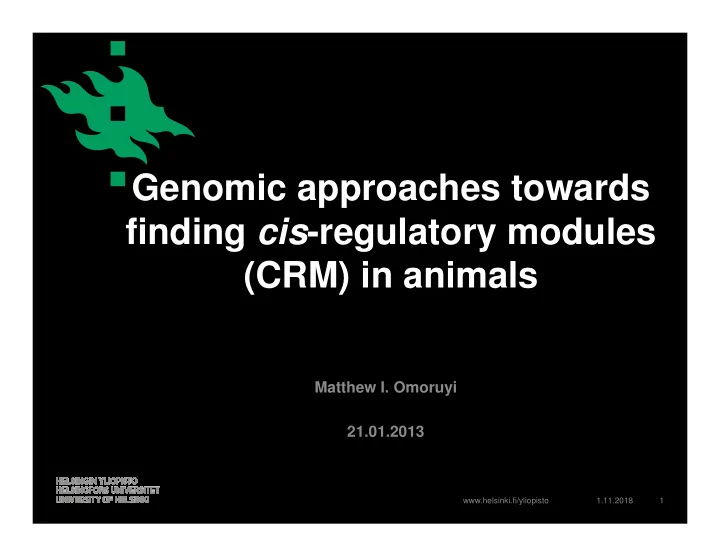

Genomic approaches towards finding cis -regulatory modules (CRM) in animals Matthew I. Omoruyi 21.01.2013 www.helsinki.fi/yliopisto 1.11.2018 1
Introduction CRM is a stretch of DNA, usually 100 – 1000 DNA base pairs in length, where a number of transcription factors can bind and regulate expression of nearby genes www.helsinki.fi/yliopisto 1.11.2018 2
Introduction They are typically located on the same DNA as the gene they control (cis) CRM includes, but not limited to the following Locus control regions Promoters Enhancers Silencers Boundary Control elements and Other modulators Eläinlääketieteellinen tiedekunta / Henkilön nimi / Esityksen nimi www.helsinki.fi/yliopisto 1.11.2018 3
Typical examples in understanding gene expression The development of animals from zygote to adults requires the expression of a specific set of genes at each developmental stage Eläinlääketieteellinen tiedekunta / Henkilön nimi / Esityksen nimi www.helsinki.fi/yliopisto 1.11.2018 4
The differentiation of cells into distinct tissues and organs also requires the expression of a specific set of genes in each cell types Eläinlääketieteellinen tiedekunta / Henkilön nimi / Esityksen nimi www.helsinki.fi/yliopisto 1.11.2018 5
Gene expression Eläinlääketieteellinen tiedekunta / Henkilön nimi / Esityksen nimi www.helsinki.fi/yliopisto 1.11.2018 6
Importance of CRM 1. Expand our understanding of biology 2. Application in medicine (susceptibility to diseases) 3. Proper understanding of evolution Eläinlääketieteellinen tiedekunta / Henkilön nimi / Esityksen nimi www.helsinki.fi/yliopisto 1.11.2018 7
Methods used in predicting CRM in animals 1. Searching genomic DNA for clusters of motifs that are needed for the specific binding of transcription factors 2. Comparing homologous, non-coding DNA sequences between related species 3. Direct assays for DNA sequences with epigenetic features that are characteristic of regulatory regions Eläinlääketieteellinen tiedekunta / Henkilön nimi / Esityksen nimi www.helsinki.fi/yliopisto 1.11.2018 8
Information to help understand the methods http://www.ncbi.nlm.nih.gov/PMGifs/Genomes/micr.html • The whole-genome sequences for over 85 microorganisms • Humans, and a handful of other eukaryotic organisms Combination of results from database similarity searches and gene-predicting algorithms to identify coding sequences with good but not complete accuracy Eläinlääketieteellinen tiedekunta / Henkilön nimi / Esityksen nimi www.helsinki.fi/yliopisto 1.11.2018 9
Eläinlääketieteellinen tiedekunta / Henkilön nimi / Esityksen nimi www.helsinki.fi/yliopisto 1.11.2018 10
Softwares Eläinlääketieteellinen tiedekunta / Henkilön nimi / Esityksen nimi www.helsinki.fi/yliopisto 1.11.2018 11
Eläinlääketieteellinen tiedekunta / Henkilön nimi / Esityksen nimi www.helsinki.fi/yliopisto 1.11.2018 12
How is this done? Eläinlääketieteellinen tiedekunta / Henkilön nimi / Esityksen nimi www.helsinki.fi/yliopisto 1.11.2018 13
Methods used in predicting CRM in animals 1. Searching genomic DNA for clusters of motifs that are needed for the specific binding of transcription factors Eläinlääketieteellinen tiedekunta / Henkilön nimi / Esityksen nimi www.helsinki.fi/yliopisto 1.11.2018 14
Eläinlääketieteellinen tiedekunta / Henkilön nimi / Esityksen nimi www.helsinki.fi/yliopisto 1.11.2018 15
Eläinlääketieteellinen tiedekunta / Henkilön nimi / Esityksen nimi www.helsinki.fi/yliopisto 1.11.2018 16
2. Comparing homologous, non-coding DNA sequences between related species By comparing the genomic sequences of species at different evolutionary distances, one can identify coding sequences and conserved non-coding sequences with regulatory functions and determine which sequence are unique for a given specie www.helsinki.fi/yliopisto 1.11.2018 17
Eläinlääketieteellinen tiedekunta / Henkilön nimi / Esityksen nimi www.helsinki.fi/yliopisto 1.11.2018 18
3. Direct assays for DNA sequences with epigenetic features that are characteristic of regulatory regions Epigenetic features are reversible features on a cell’s DNA that affect gene expression without altering DNA It is based on high-throughput sequencing and mapping to reference genomes Eläinlääketieteellinen tiedekunta / Henkilön nimi / Esityksen nimi www.helsinki.fi/yliopisto 1.11.2018 19
Eläinlääketieteellinen tiedekunta / Henkilön nimi / Esityksen nimi www.helsinki.fi/yliopisto 1.11.2018 20
Pros and cons Comparing homologous, Searching genomic DNA for Direct assays for DNA clusters of motifs that are non-coding DNA sequences sequences with needed for the specific between related species epigenetic features that binding of transcription are characteristic of factors regulatory regions 1. Partial success under 1. Partial success under favourable conditions favourable conditions 2. Only small subset of CRMs is 2. Only small subset of CRMs is likely to be discovered by likely to be discovered by extreme evolutionary 1. Epigenetic marks must be extreme evolutionary constraint constraint mapped in tissues and at 3. Does not work equally in all times of development that 3. Does not work equally in all tissues are informative to the tissues question at hand 4. No sufficient specificity 4. No sufficient specificity 2. May be bias. 5. Not designed to find CRMs that 5. Not designed to find CRMs are active in only 1 specie or that are active in only 1 that are changing in a lineage specie or that are changing in specific manner a lineage specific manner Eläinlääketieteellinen tiedekunta / Henkilön nimi / Esityksen nimi www.helsinki.fi/yliopisto 1.11.2018 21
Summary/conclusion • Cis -regulatory modules are DNA sequence required to regulate gene expression • The genome of both prokaryotes and eukaryotes are available in a vast number of databases • These databases are used to predict the DNA sequence required for gene expression by different methods Eläinlääketieteellinen tiedekunta / Henkilön nimi / Esityksen nimi www.helsinki.fi/yliopisto 1.11.2018 22
Summary/conclusion Given the limitations of methods based on sequence motifs and comparative genomics, direct measurement of diagnostic epigenetic features should lead to improved methods for CRM prediction. Particular epigenetic features are highly correlated with CRMs, and progress is being made in finding combinations of these features that may distinguish different types of CRM. Eläinlääketieteellinen tiedekunta / Henkilön nimi / Esityksen nimi www.helsinki.fi/yliopisto 1.11.2018 23
Eläinlääketieteellinen tiedekunta / Henkilön nimi / Esityksen nimi www.helsinki.fi/yliopisto 1.11.2018 24
Recommend
More recommend